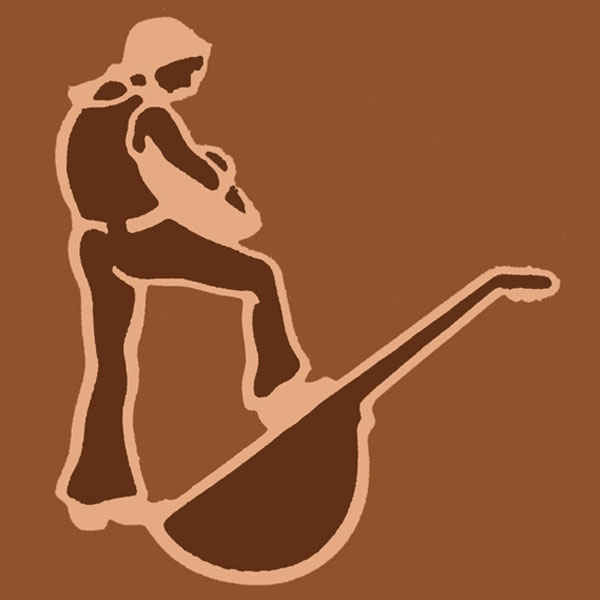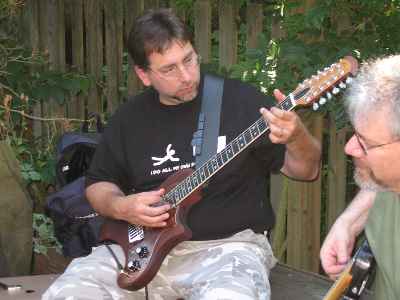|
|

Joined:
February 2013
Posts: 16
Location: Sacramento, CA | I just got a beat up old Ovation and after tons of work, I just made it playable.
I've never been a fan of Ovations, but wow, the sound is really incredible out of this thing.
I think I've been converted now!
I had to reattach the bridge, which seems to be working, but it seems to put a lot of pressure on the back of the body.
The old bridge screws had pulled out, so I replaced them and put much wider washers under the top.
I also added an extra screw right in the middle of the back part of the bridge with the widest washer I could fit in there. Not pretty, but functional.
The question I have is what other problems might develop?
I don't want to sink more money into it unless it's going to hold together. |
|
| |
|

Joined:
February 2013
Posts: 16
Location: Sacramento, CA | Well, I might as well show what I've done so far...
First, Here is the finished product. Extremely low action!! Better than my C.F. Martian.

I had to remove what was left of the bridge and then Dremel off all the old "Gorella" glue down to the bare wood.
I then replaced the two existing screws and added a third one right in the middle. I glued the bridge down with Carpenters wood glue. I did not have a way to heat up Hide glue, so I went the best way I could.


No wonder the bridges on these things kept pulling out.
Here is a photo of the original washer on the right used to hold the bridge down. Sooooo small! It was just a matter of time before it pulled through the wood top of the guitar!
The middle washer is the one I used to replace the original washers with the new screws.
The left washer is the one I used for the new center screw.
I doubt these will ever pull through the top.

I also had to replace the end pin anchor. I just used a standard Molly bolt. I cut two notches in the body to accommodate the new Molly bolt and then after it anchored, I replaced the screw with a counter sink screw to anchor the new strap button.

I don't stock nuts, so I repaired the nut with Q-Bond. On small jobs I just use Baking soda and super glue, but this one needed to be rebuilt. I then cut the repaired nut to just the right depth.
It also had some pretty deep grooves in the frets, so I did a fret level and dressing on the frets. I also replaced some of the tuners. Some were broken, others, I just replaced because I had a few in stock and they tuned much smoother than the original tuners.

Once the truss rod was set, the action came out very good. Very, very low action.
Since the latest craze is reliced guitars, I'm going to leave it just as it is. No refinish. The only thing left to do is put on a new headstock logo.
Edited by photoweborama 2013-02-21 1:11 PM
|
|
| |
|

Joined:
August 2007
Posts: 1008
Location: Tuscany, Italy | Nice job Mark. I think you'll have great time with your rescued guitar. |
|
| |
|

Joined:
February 2013
Posts: 16
Location: Sacramento, CA | I might add, it's not pretty, but functional. I really wanted to just see if it was playable.
Maybe I should have used prettier hardware, since it turned out so well...
Well it is the Relic look.... |
|
| |
|

Joined:
February 2013
Posts: 16
Location: Sacramento, CA | maremagnum - 2013-02-21 11:46 AM
Nice job Mark. I think you'll have great time with your rescued guitar. Thank you! It's hard to go back to my other guitar. The Ovation puts out so much more volume. You get addicted to that! |
|
| |
|
Joined:
February 2013
Posts: 5
| Looks like you've done a bang-up job on that old balladeer. You can't beat the volume on those vintage deep-bowls. you did glue the bridge down as well as the screws correct? It's ready for a whole 'nother lifetime. |
|
| |
|
Joined:
March 2005
Posts: 12759
Location: Boise, Idaho | Many bridges aren't bolted down at all, just glued. That guitar had a hard life. |
|
| |
|

Joined:
February 2013
Posts: 16
Location: Sacramento, CA | fretboardwizard - 2013-02-21 2:01 PM
Looks like you've done a bang-up job on that old balladeer. You can't beat the volume on those vintage deep-bowls. you did glue the bridge down as well as the screws correct? It's ready for a whole 'nother lifetime.
Yes, I'm looking forward to taking it places. I go to a few private music festivals each year. I'm looking forward to showing it off then to the other musicians. If I by chance scare up a band to play at one of these things, I'm using it on stage!  |
|
| |
|

Joined:
December 2006
Posts: 6996
Location: Jet City | You and DaveKell should meet up. Y'all could start a guitar rescue biz |
|
| |
|

Joined:
February 2013
Posts: 16
Location: Sacramento, CA | Well, here is an update.
It's all holding together well, and the action in incredible.
When I first strung it up, it started to bulge quite a bit behind the bridge.
As time went by, the area on the sides of the sound hole and in front of the bridge, that area started to depress.
Now, the bulge behind the bridge had started to level out, but not completely, the depressions in front of the brides have not gotten any worse, and unless you look at it in certain angles, the top seems almost level.
It just seems to get a little bit better every day, which surprises me. I'd figure the top would separate from the bowl, but its all coming together nicely! |
|
| |
|

Joined:
June 2012
Posts: 2339
Location: Pueblo West, CO | photoweborama - 2013-02-21 11:08 AM
I then replaced the two existing screws and added a third one right in the middle. I glued the bridge down with Carpenters wood glue. I did not have a way to heat up Hide glue, so I went the best way I could.
Nice job. Heating hide glue isn't that difficult. You can buy an electric glue pot from places like StewMac, but they're pretty expensive. A cheaper route is to do what I did. I think I spent $50 to put together an electic glue pot of my own, including the cost of the glue. I bought Brooklyn Tool & Craft 192-gram strength, which is what is recommended for musical instruments. It comes in a 1-lb. bag, which is enough to last me a long, long time. I bought a Sunbeam Electric Hot Pot that can be used as a double-boiler. I also bought a kitchen thermometer. I heat my hide glue in a coffee cup. I modified the top of the soup pot by inserting a small aluminum tube I bought at the local hobby store. This allows me to measure the temperature of the glue without the thermometer resting on the bottom of the cup. I drilled another hole in the top of the soup pot that I use to dip the acid brush into the glue. This setup works well because it keeps the glue at the right temperature which allows plenty of working time without the glue cooling down too much. Because the glue cup is kept inside a warm, moist environment it never skins over. Dan 


Edited by DanSavage 2013-03-22 10:19 AM
|
|
| |
|

Joined:
February 2013
Posts: 16
Location: Sacramento, CA | How does hide glue work? I've never even seen anyone else uses it before. |
|
| |
|

Joined:
December 2003
Posts: 13996
Location: Upper Left USA | Hide glue can be melted using heat without damaging the wood unlike epoxies. |
|
| |
|

Joined:
June 2012
Posts: 2339
Location: Pueblo West, CO | Most glues form a simple mechanical bond with the parts being joined. Hot hide glue (HHG) forms a chemical bond. What this means is that you don't need to sand the joints to rough up to surface.
To use HHG, you simply add water to the glue granules, then heat it to 150 degrees.
While it's in the liquid state, you brush a thin layer onto each of the two sides of the joint, then squeeze or clamp the two pieces together until the glue takes a set. It only takes a few minutes for this to happen. Once the glue takes a set, it will continue to shrink and draw the joint together. After it hardens, you can easily clean up any excess with water.
One of the major differences between HHG and other glues like carpenter's glue (aliphatic resin) and epoxy is that hide glue doesn't soften when it gets heated. This prevents creep. If you leave a guitar with carpenter's glue or epoxy in an area where it will get hot, these glues will soften which will allow the glue joint to come undone.
HHG doesn't creep when it gets hot. The only other glue I've used that has this characteristic is cyanoacrylate. (CA, or super glue)
One of the desirable features of HHG is that joints can be easily separated using only steam. So, if you make a mistake and the joint isn't quite right, you can use steam to soften the glue and reset the joint.
The classic example of this in luthiering is using hide glue for neck to body joint. This allows for relatively easy neck resets. Not as easy as a bolt-on neck, but a lot easier than necks glued on with aliphatic resin or epoxy. Interestingly, another characteristic of CA is that it dissolves when it gets wet. It doesn't happen as fast as HHG, but it will happen. Technically, the CA doesn't dissolve. It just loses its grip when the underlying material becomes wet. Separating a CA glue joint on a guitar requires that the wood would need to get a wet for quite a while, which is not a good thing for guitars.
The downside to HHG is that it has a fairly short working time when compared to aliphatic resin or epoxy. As the glue cools, it starts to harden and resists flowing out of the glue joint. Once the HHG starts to gel, it becomes increasingly difficult to get it to squeeze out and form a tight glue joint.
You can extend the working time by preheating the joints so the glue doesn't cool as quickly as it would when you brush the hot glue onto a cold surface. I used HHG and the glue pot in the pics to fix a guitar that had a broken headstock. I used a heat gun and an IR thermometer to preheat the two sides of the joint to 150 degrees before brushing on the HHG.
Another trick is to make a thinned batch of HHG, called sizing, then brush it onto the joints so it flows into the cracks and crevices and then let it dry. When you're ready to glue the pieces, you brush on another thin layer of HHG to reactivate the sizing and squeeze the joint together.
Here's a couple of pics of the headstock repair I did. I let the glue joint dry for a couple of weeks then filled in the missing finish with ZPoxy. To match the color of the original finish I added dry pigment before I mixed the two parts of the epoxy. I wanted to try my hand a luthiering and HHG, so I found a broken guitar on eBay and used it for experimentation. In addition to fixing the neck and repairing the finish, I also made the bone nut. It's not perfect, but I learned a lot and the guitar plays great. Before: 
After: 

Edited by DanSavage 2013-03-29 10:10 AM
|
|
| |
|
Joined:
June 2012
Posts: 112
Location: Bristol England | Dan,
Thanks for your post. Very informative and concise. I've learned a lot and had a lot of questions answered.
Cheers James |
|
| |
|

Joined:
June 2012
Posts: 2339
Location: Pueblo West, CO | You're welcome.
BTW, did you know that the glue used for envelopes and paper tape is actually HHG? It is.
That's why you can steam open an envelope, then re-seal it. Now you know why the glue on envelopes tastes bad.
One other piece of trivia.
HHG is made from animal proteins such as bones, horns and skin. Animal gelatin is derived mainly from beef and pigs and ta-da! --horses. (Remember the old saying about horses being sent to the glue factory?)
Food-grade animal gelatin is also used in a wide variety of food products including yogurt, cream cheese and margarine. (Don't tell the vegans - heh heh heh) |
|
| |
|
Joined:
March 2005
Posts: 12759
Location: Boise, Idaho | Dan, your knowledge is impressive--but a little scary. |
|
| |
|
Joined:
April 2010
Posts: 823
Location: sitting at my computer | Interesting stuff Dan, but now I'm beginning to wonder if maybe you're Adam Savage's (Myth Busters) smarter brother! Have you C4'd any Lyrachord® bowls into oblivion... or made any acoustic guitars entirely out of duct tape??   btw - I've heard that vegan is an ancient Mayan word that means lousy hunter. |
|
| |
|
Joined:
July 2008
Posts: 21
Location: north coast ohio | Glad to see an old O given new life.
Did not want to make the 75 mile roundtrip to the local home depot so followed the glue in kitchen tip from Frank Ford site and used knox gelatin when I built my O size guitar. Mixed it up and used mr coffee burner for the warmer. Four years later it still holds together |
|
| |
|

Joined:
January 2009
Posts: 1249
Location: Texas | Dan...+1 on your post. |
|
| |
|

Joined:
February 2013
Posts: 16
Location: Sacramento, CA | Ok!!! I finally finished this wonderful Ovation. It's been done for quite some time, but I just put the headstock logo on. The only real thing holding me back was that I ran out of ink on my printer. Here is the final shot!!  It looks better in real life. I used bounce flash, which makes the top edges look white, but normally you don't really notice the lines. I think it looks pretty good. not perfect like the real one, but pretty good! |
|
| |
 New old 1973 Ovation
New old 1973 Ovation New old 1973 Ovation
New old 1973 Ovation